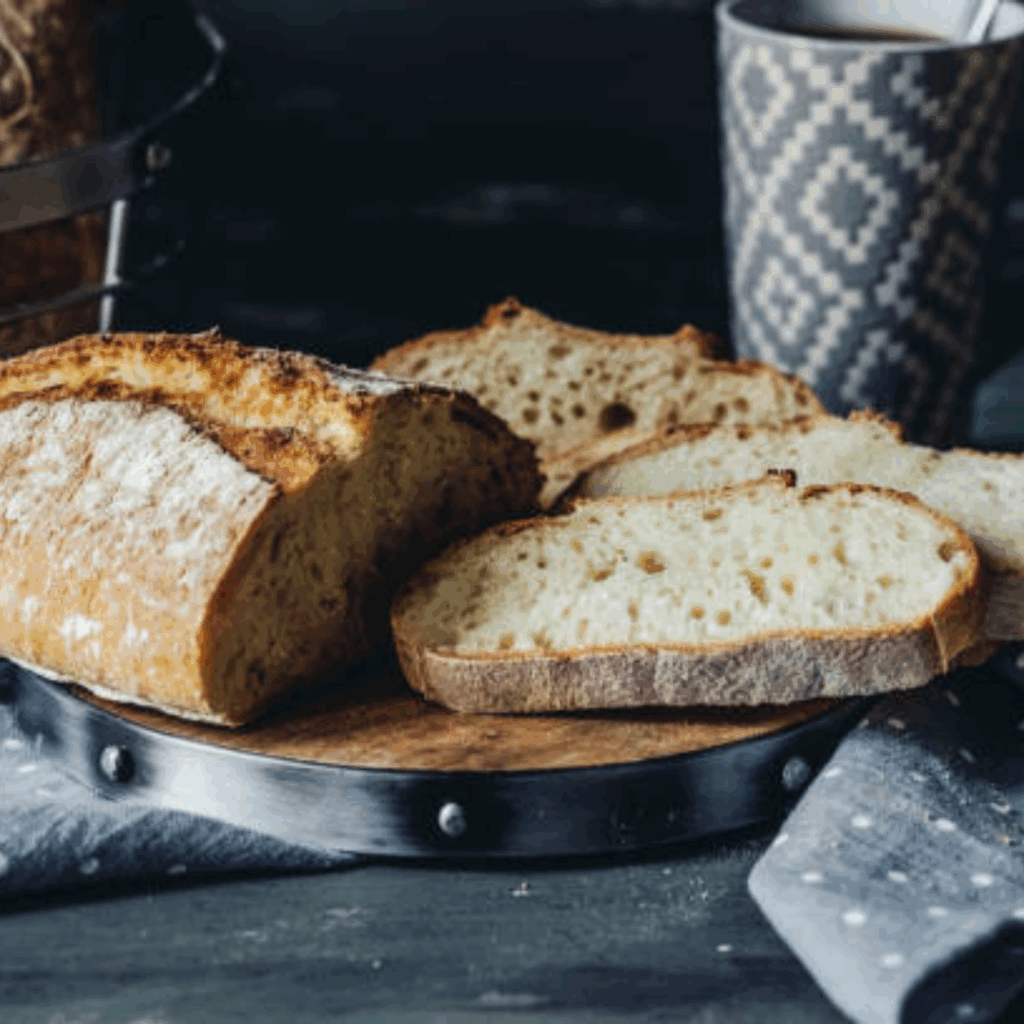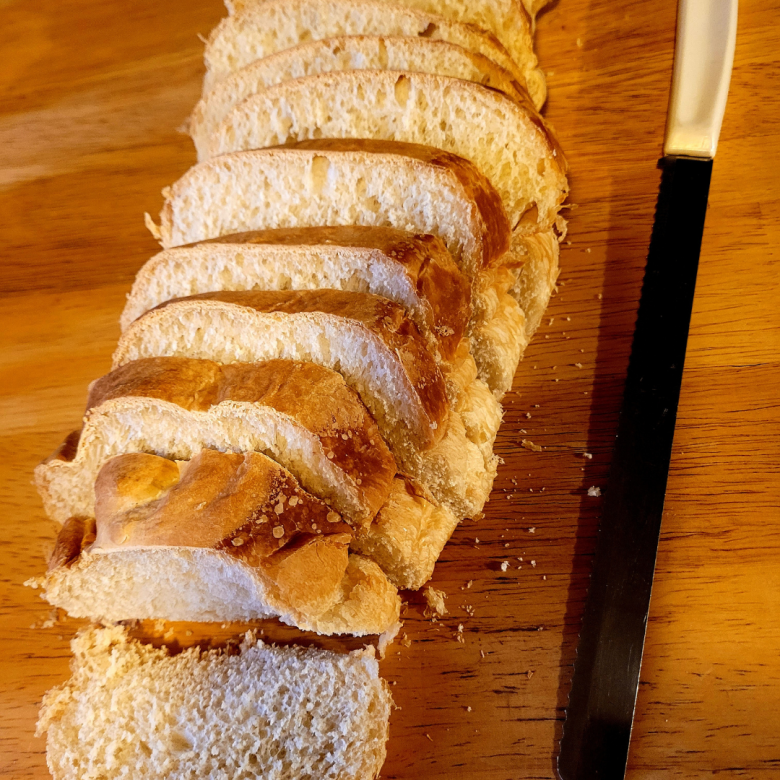Learn how to make sourdough bagels from scratch with this easy step-by-step recipe. From mixing and shaping to boiling and baking, these homemade bagels are chewy, flavorful, and perfect for breakfast or snacks. Discover tips for getting that golden crust and authentic bagel texture using your sourdough starter.
There’s just something magical about pulling a tray of freshly baked sourdough bagels out of the oven. The chewy texture, the tangy flavor from my sourdough starter, and that golden, shiny crust make them a breakfast worth slowing down for. When I first started making bagels, I thought they’d be complicated, but it turns out they’re surprisingly simple once you get the hang of it. With just a few ingredients and some patience, you can create bagels that taste better than anything from the store—and the best part is, your kitchen will smell heavenly the whole time!
This is a pinnable post. Tap or hover over any image in this post to pin to your Pinterest Boards.

Introduction to Sourdough Bagels
What are Sourdough Bagels?
If you’re a fan of bagels and the tangy flavor of sourdough bread, then you’re in for a treat with sourdough bagels. These delicious rings of chewy goodness are made using a sourdough starter instead of commercial yeast, giving them a unique and complex flavor profile.
Why Make Sourdough Bagels?
While you can easily buy bagels from your local bakery or grocery store, there’s something special about making your own sourdough bagels. Not only do they taste amazing, but the process of creating and working with a sourdough starter adds an element of satisfaction and accomplishment. Plus, you can customize your bagels with different toppings and flavors to suit your preferences.
Ingredients and Equipment Needed
Before you embark on your sourdough bagel-making adventure, it’s important to gather all the necessary ingredients and equipment.
Here’s what you’ll need:
- Sourdough Starter: You’ll need an active and bubbly sourdough starter to give your bagels that distinct tangy flavor.
- Bread Flour: Bagels require high-protein flour to achieve the chewy texture we all love. Bread flour is the way to go.
- Water: Trusty H2O is essential for hydrating your dough and activating the sourdough starter.
- Salt: Just a pinch of salt helps enhance the flavors of your bagels.
- Sugar: A small amount of sugar adds a touch of sweetness to balance out the sourness.
- Toppings: Get creative with toppings like sesame seeds, poppy seeds, everything seasoning, or even cinnamon sugar.
- Mixing Bowl, Baking Sheet, Parchment Paper, and a Pot for boiling water: These are the basic tools you’ll need to shape and bake your bagels.
Creating and Maintaining a Sourdough Starter
What is a Sourdough Starter?
A sourdough starter is a wild yeast culture that you create and nurture to make your sourdough bread and bagels rise. It’s a living organism that requires regular feeding to stay active and bubbly.
Creating a Sourdough Starter
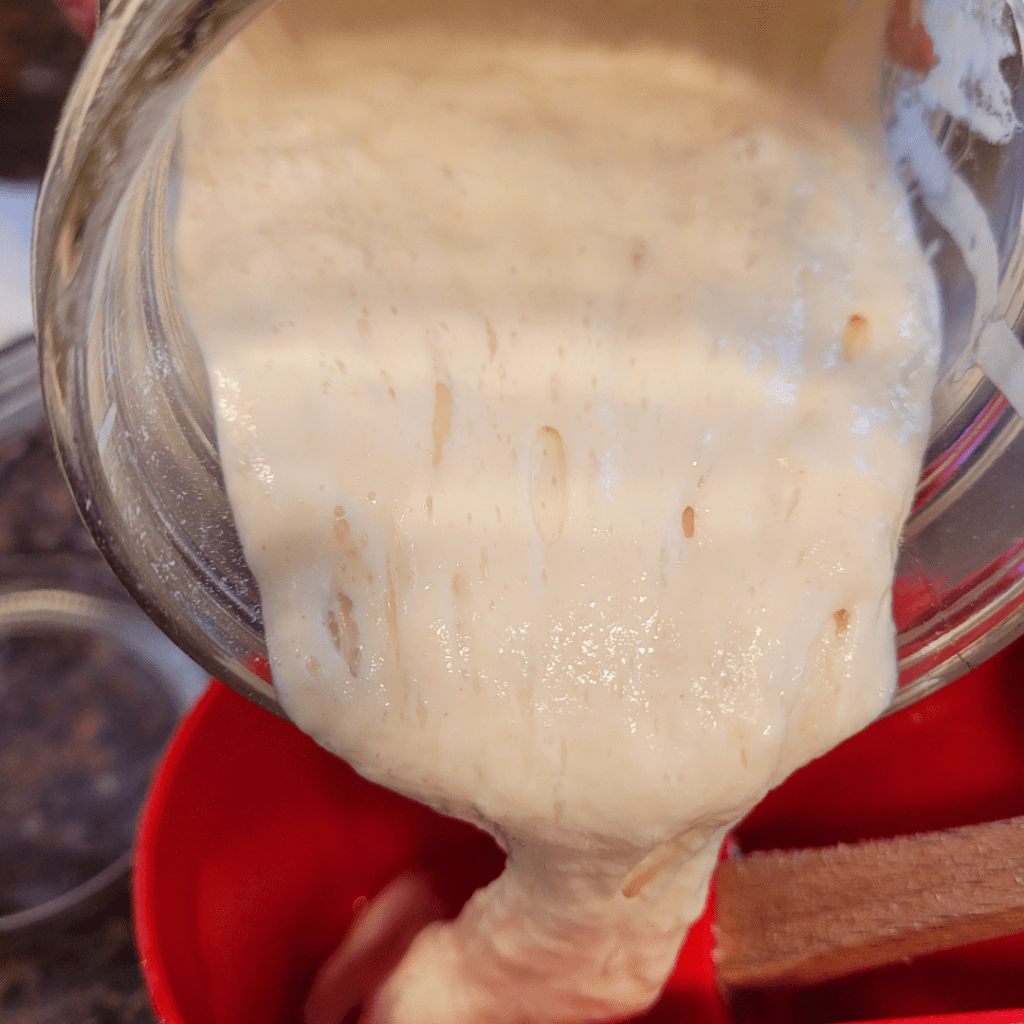
Making a sourdough starter is like starting your own little yeast farm. Mix flour and water together, let it sit, and let nature work its magic. Every day, you will do a series of discarding and feeding your new sourdough starter. In a few days, you’ll have a bubbling jar of sourdough starter ready to be used in your bagel dough.
For more in-depth information and step-by-step instructions in crafting your very own wild sourdough starter, I have written a separate post regarding this information. Just visit the following link to start your sourdough starter.
The Ultimate Guide to Crafting a Perfectly Tangy Wild Sourdough Starter
Maintaining and Feeding the Sourdough Starter
Once you have a sourdough starter, you’ll need to regularly feed it to keep it happy and active. This involves discarding a portion of the starter and adding fresh flour and water to refresh it. Think of it as your new living pet that sits on your counter waiting to be fed and used.
Preparing the Bagel Dough
Mixing the Ingredients
Now that you have a lively sourdough starter, it’s time to mix the ingredients for your bagel dough. Combine the flour, water, sourdough starter, salt, and a touch of sugar in a mixing bowl. Use your hands or a stand mixer to bring everything together into a smooth and slightly sticky dough.
Kneading and Resting the Dough
Once the dough is mixed, turn it out onto a lightly floured surface and knead it until it becomes smooth and elastic. This process helps develop gluten, which gives the bagels their chewy texture. After kneading, let the dough rest and rise for a few hours, until it doubles in size. This waiting period allows the flavors to develop and the dough to become easier to handle. I usually do this the night before so that my dough can rest all night long and be ready for shaping in the morning.
Shaping and Boiling the Bagels
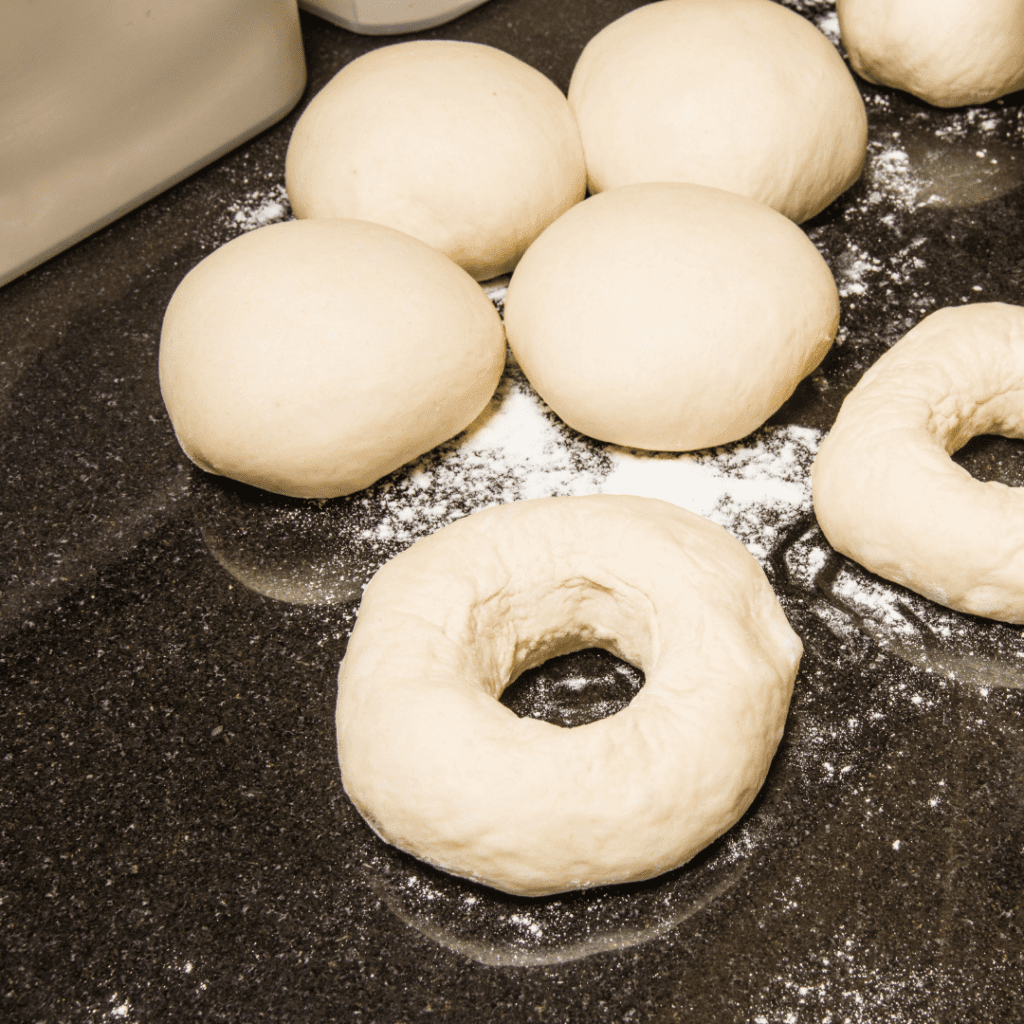
Shaping the Bagels
Now that your dough has finished its delightful rise, it’s time to shape those bagels! Grab a handful of dough, about the size of a tennis ball. With your palms, roll it into a smooth ball. Then, poke your thumb through the center and gently stretch the hole until it’s about 1.5 to 2 inches in diameter. Repeat this process for the rest of the dough.
Don’t worry if your bagels aren’t perfect circles—imperfections are what make them unique and even more delicious! Be sure to stretch out the holes because they will puff out and close a little bit during the second rise. After shaping, them, place them on a parchment-lined baking sheet to double in size.
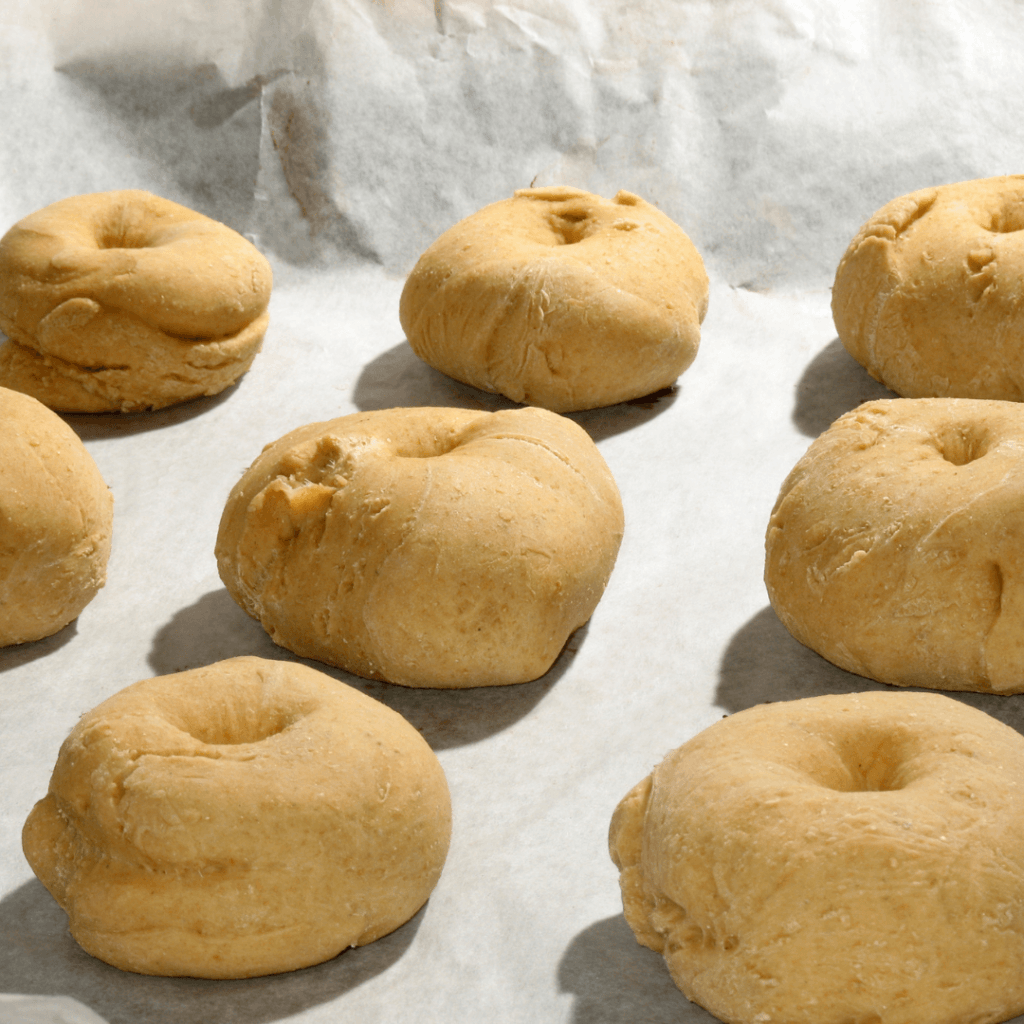
Boiling the Bagels
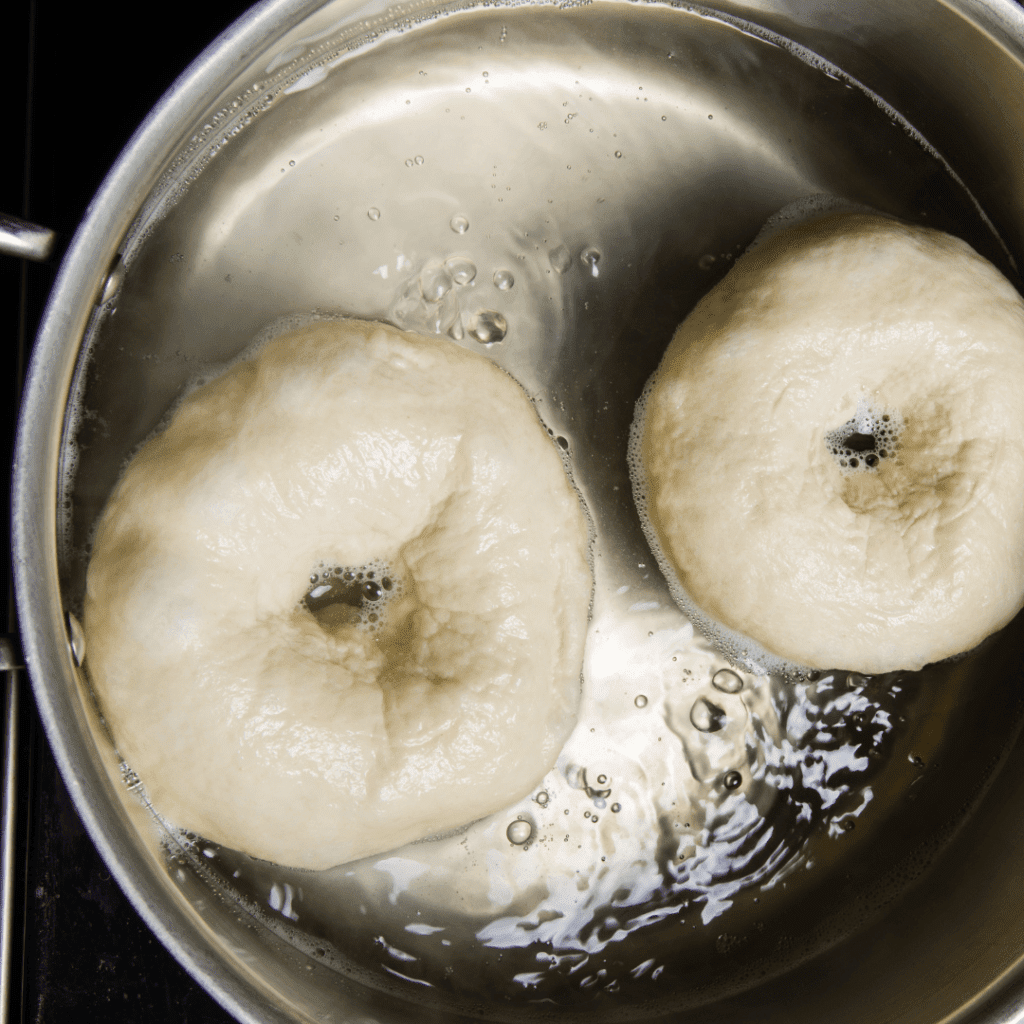
Now, for the part that gives bagels their signature chewiness—boiling! Fill a large pot with water and bring it to a rolling boil. Then, carefully lower a few bagels into the boiling water, being cautious not to overcrowd them. Let them simmer for about a minute on each side, flipping them to boil for another minute.
The boiling step not only helps achieve the bagels’ iconic texture, but also gives them a shiny and beautifully golden crust. So don’t skip this step, unless you want to risk disappointing your taste buds! After boiling each one, place them back onto the parchment-lined baking sheet.
Baking and Finishing Touches
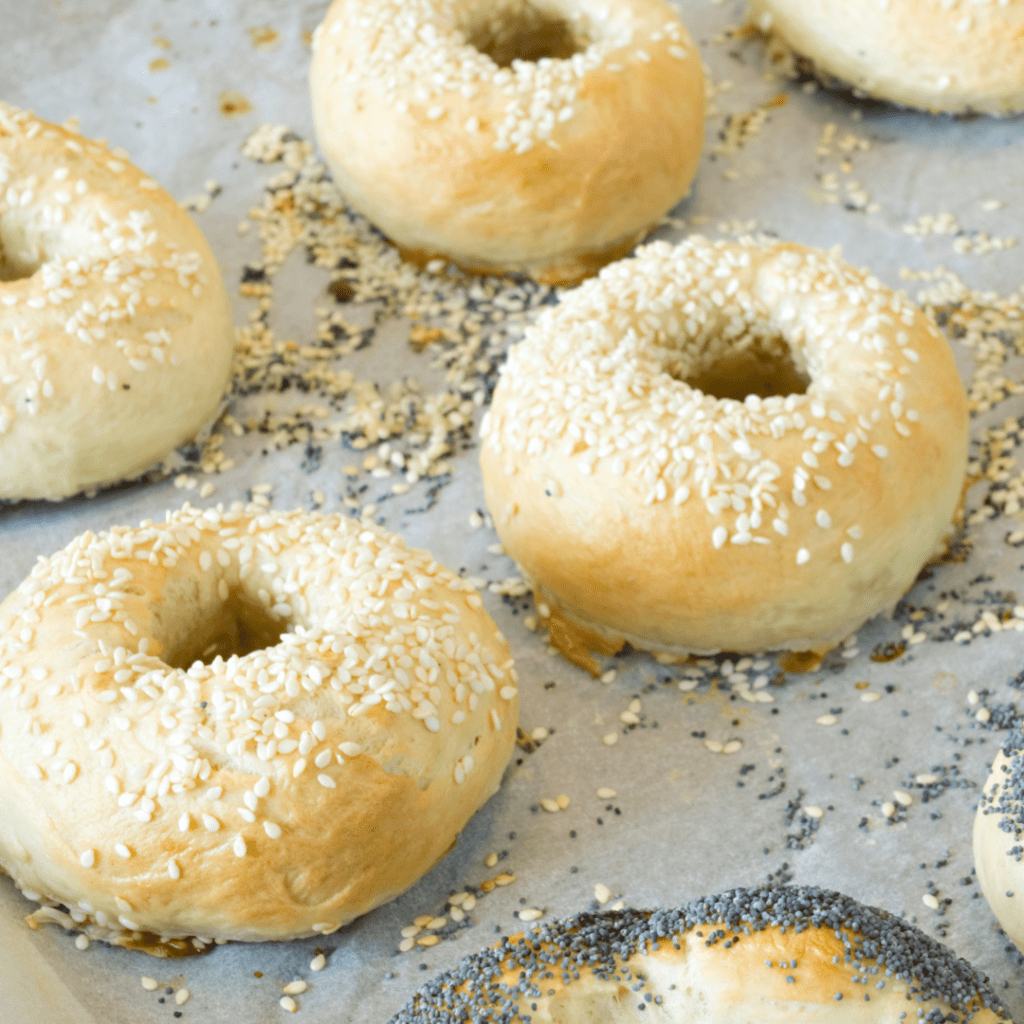
Adding Toppings and Finishing Touches
You’ve made it to the fun step—toppings and finishing touches! After removing the bagels from the water bath, feel free to get creative. Sesame seeds, poppy seeds, everything bagel seasoning, or even a sprinkle of cinnamon and sugar are all fantastic options. Gently press the toppings onto the wet bagels after boiling them, and they’ll stick like a charm.
Preparing the Oven
While your bagels are happily sitting around waiting for the next step, preheat your oven to 425°F (220°C). Make sure the oven rack is in the center position so that your bagels receive uniform heat.
Baking the Bagels
Pop the baking sheet into the preheated oven and let the bagels bake for about 20-25 minutes or until they turn a lovely golden brown color. The aroma wafting through your kitchen will make it almost impossible to wait, but trust me, the patience will be worth it!
Now, all that’s left to do is sit back, admire your beautiful homemade sourdough bagels, and get ready to enjoy a taste of pure satisfaction!
Variations and Toppings for Sourdough Bagels
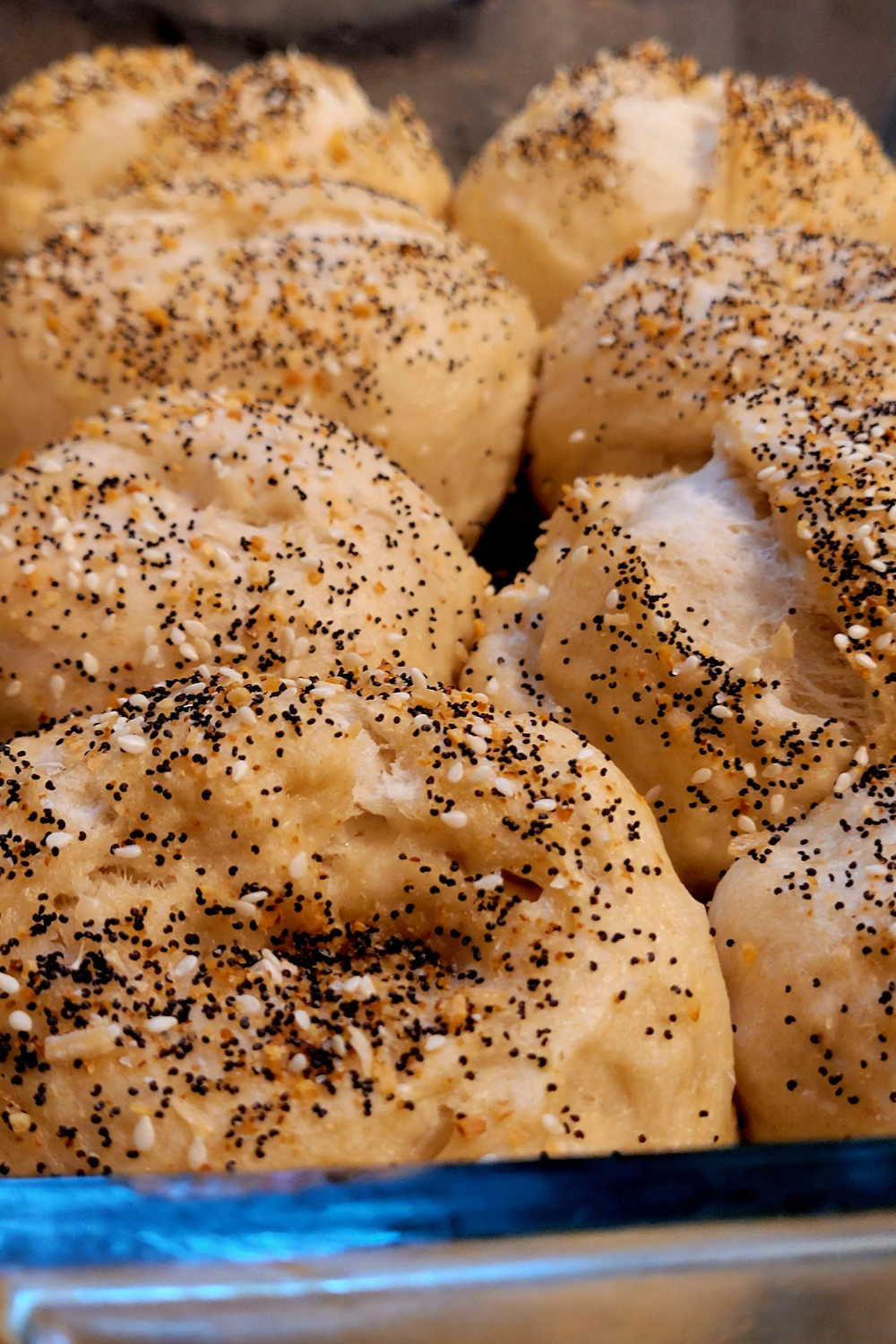
Sweet and Savory Variations
Sweet Variations
Sourdough bagels are the perfect blank canvas for your culinary creativity. For a sweet twist, you can add raisins, dried cranberries, or even chocolate chips to the dough.
Savory Variations
Craving something savory? Mix in some herbs, minced garlic, jalapenos, or grated cheese. The possibilities are truly endless, so don’t be afraid to experiment and make these bagels truly your own.
Popular Toppings for Sourdough Bagels
When it comes to toppings, tradition has its perks. Classic choices like sesame seeds, poppy seeds, and everything bagel seasoning are beloved for a reason. If you want to venture into new territory, try some smoked sea salt, sunflower seeds, or even a drizzle of honey for a touch of sweetness. Don’t be afraid to mix and match—you might discover a new favorite combination!
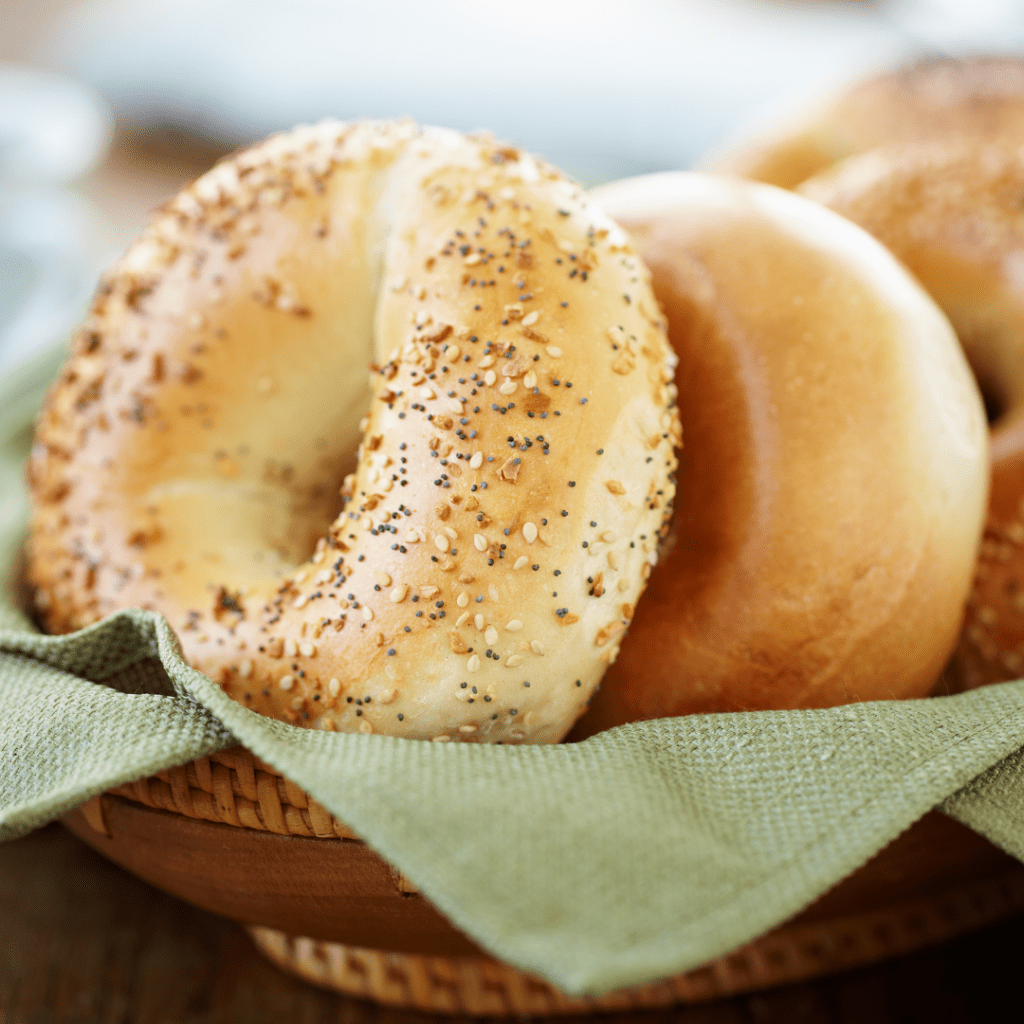
Tips and Troubleshooting for Perfect Sourdough Bagels
- For a more pronounced sourdough flavor, let your dough ferment in the fridge overnight or up to 24 hours before shaping and boiling.
- Don’t have a sourdough starter? Don’t fret! You can make a makeshift starter by mixing equal parts flour and water and letting it sit at room temperature for a couple of days until it becomes bubbly and active.
- If your bagels are dense and heavy, it could be a sign of over-mixing the dough or not allowing it to rise enough. Give the dough a gentle touch and be patient during the rising process.
- To achieve a chewier texture, you can add a tablespoon of barley malt syrup or sugar to the boiling water. This will also enhance the bagels’ shine and give them that sought-after glossy exterior.
- Don’t be discouraged if your first batch doesn’t turn out perfect. Like any skill, making bagels takes practice. Embrace the imperfect and keep experimenting—you’ll become a sourdough bagel master in no time!
Conclusion
In conclusion, making sourdough bagels can be a rewarding and delicious experience. With a little time and effort, you can enjoy the satisfaction of biting into a freshly baked, homemade sourdough bagel that is bursting with flavor. From experimenting with different toppings and variations to perfecting your shaping and baking techniques, there is always room to explore and personalize your sourdough bagel creations. So, get started on your sourdough journey and indulge in the comforting and flavorful world of homemade sourdough bagels.
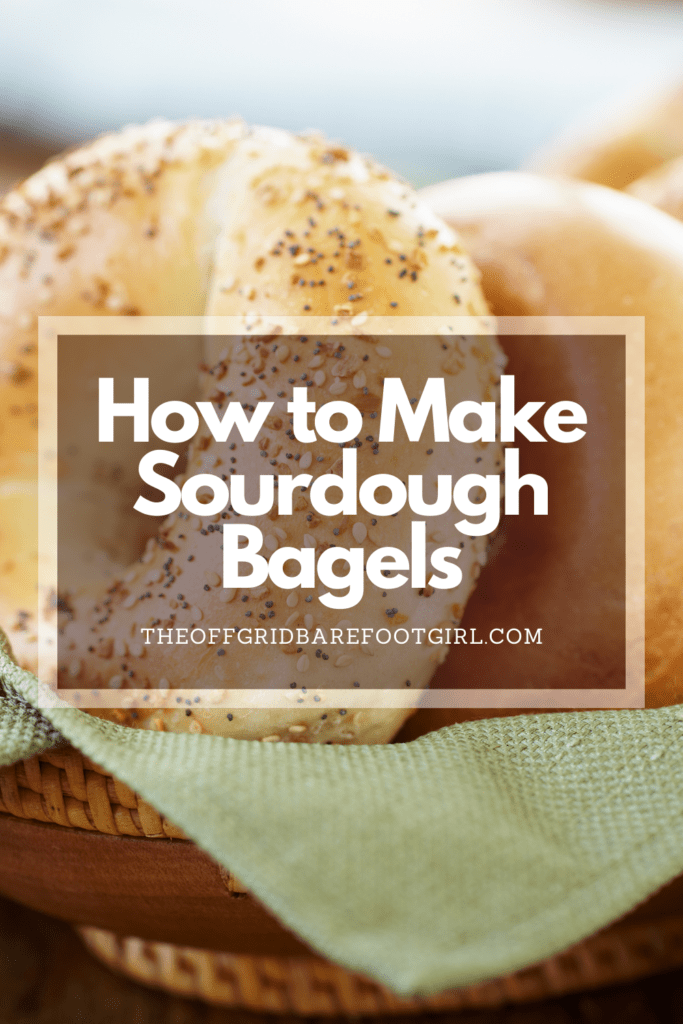
Frequently Asked Questions
1. Can I make sourdough bagels without a sourdough starter?
While sourdough bagels traditionally require a sourdough starter to achieve their unique flavor and texture, there are alternative methods that use commercial yeast. However, using a sourdough starter will provide a more authentic and nuanced taste.
2. How long does it take to make sourdough bagels?
The process of making sourdough bagels typically takes around 24 to 48 hours, depending on the fermentation time of the sourdough starter and the resting periods for the dough. Patience is key to allowing the flavors to develop and the dough to rise properly. Just do some other things around the house while waiting for them to be ready!
3. Can I freeze sourdough bagels?
Absolutely! Sourdough bagels freeze well and can be stored for up to three months. Simply allow them to cool completely, place them in an airtight container or freezer bag, and store them in the freezer. When ready to enjoy, thaw them at room temperature or lightly toast them before serving.
4. What should I do if my sourdough bagels turn out too dense?
If your sourdough bagels turn out too dense, it could be due to overproofing or underproofing the dough, or insufficient kneading. Ensure that the dough has properly risen during the resting periods and that it is kneaded until it reaches the desired consistency. Adjusting the fermentation time and the amount of starter used can also help achieve a lighter texture.
Sourdough Bagels Recipe
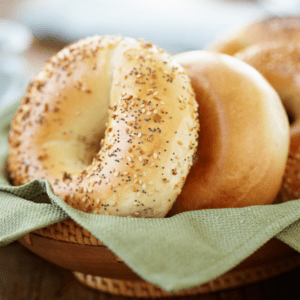
Sourdough Bagels Recipe
Equipment
- 1 mixing bowl
- 1 baking sheet.
- 1 pot.
Ingredients
- ½ cup sourdough starter.
- 1 cup warm water.
- 2 tbsp sugar.
- 2 tsp salt.
- 4 cups bread flour.
Toppings of Choice
- Sesame seeds.
- Poppy seeds.
- Everything seasoning.
- Cinnamon and sugar.
Instructions
Mixing the Ingredients
- Combine the flour, water, sourdough starter, salt, and a touch of sugar in a mixing bowl. Use your hands or a stand mixer to bring everything together into a smooth and slightly sticky dough.
Kneading and Resting the Dough
- Once the dough is mixed, turn it out onto a lightly floured surface and knead it until it becomes smooth and elastic. This process helps develop gluten, which gives the bagels their chewy texture.
- After kneading, let the dough rest and rise for a few hours, until it doubles in size. This waiting period allows the flavors to develop and the dough to become easier to handle. I usually do this the night before so that my dough can rest all night long and be ready for shaping in the morning.
Shaping the Bagels
- Grab a handful of dough, about the size of a tennis ball. With your palms, roll it into a smooth ball. Then, poke your thumb through the center and gently stretch the hole until it's about 1.5 to 2 inches in diameter. Repeat this process for the rest of the dough. This recipe typically makes 8 bagels per batch.
- Don't worry if your bagels aren't perfect circles—imperfections are what make them unique and even more delicious! Be sure to stretch out the holes because they will puff out and close a little bit during the second rise.
- After shaping, them, place them on a parchment-lined baking sheet to rise until doubled in size.
Boiling the Bagels
- Fill a large pot with water and bring it to a rolling boil. Then, carefully lower a few bagels into the boiling water, being cautious not to overcrowd them. Let them simmer for about a minute on each side, flipping them to boil for another minute.
- Place them back onto the parchment-lined baking sheet.
Adding Toppings and Finishing Touches
- Gently press the toppings of choice onto the wet bagels after boiling them, and they'll stick like a charm.
Preparing the Oven
- Preheat your oven to 425°F (220°C). Make sure the oven rack is in the center position so that your bagels receive uniform heat.
Baking the Bagels
- Pop the baking sheet into the preheated oven and let the bagels bake for about 20-25 minutes or until they turn a lovely golden brown color.
- Cool completely on a cooling rack and enjoy!
Summary
I hope I have inspired you to bake your very own bread loaves to enjoy and share with your friends and family.
If you were encouraged by this post, I invite you to check out my FREE Printables Page for fun free printables, planners, and charts.
ENTER MY FREE Printables Page HERE
Here are some more of my bread-making inspiration posts to check out!
The Best Pumpkin Zucchini Bread
The Only Pumpkin Muffin Recipe You’ll Ever Need!
How to Make Banana Split Quick Bread
How to Make S’mores Quick Bread
How to Make Jelly Donut Quick Bread
Lemon Blueberry: How to Make Lemon Blueberry Sourdough Focaccia
How to Make Sourdough Lemon Supreme Quick Bread
Lemon Supreme: How to Make Sourdough Lemon Supreme Quick Bread
How to Make Sourdough Strawberry Cheesecake Muffins
How to Make Chai-Spiced Sourdough Banana Bread
The Best Old Fashioned Sourdough Banana Muffins
How to Make Honey Sourdough Bread
Blueberry: How to Make Lemon Blueberry Sourdough Quick Bread
Pizza: How to Make Pizza Sourdough Focaccia
Carrot Cake: How to Make Carrot Cake Sourdough Focaccia
Easy and Delicious Hershey’s Kisses Sourdough Bread
How to Make Amish Whoopie Pies!
Lazy Cinnamon Rolls: How to Make Easy Cinnamon Rolls the Lazy Way!
Lembas Bread: How to Make Elven Lembas Bread: A Taste of Rivendell
Gnome Bread: How to Make a Sourdough Gnome Bread
How to Make Sourdough Strawberry Cheesecake Muffins
The Best Hoagie Buns Recipe Made From Scratch!
Pumpkin: How to Make Chocolate Chip Pumpkin Bread
More Recipes!
Sweet Potato Bread: How to Make Sweet Potato Bread
Chocolate Chip Cookies: How to Make Chocolate Chip Cookie Bread
Carrot Cake Quick Bread: How to Make Carrot Cake Quick Bread
How to Make Strawberries and Cream Sourdough Bread
How to Make S’mores Sourdough Bread
July 4th Bread: How to Make a Firecracker Marble Bread Braid
Artisan Bread: How to Make Artisan Bread
Challah Bread: How to Make a 6 Braided Challah Bread
Sweet Bread: How to Make Sweet Bread
Blessings,
The Off Grid Barefoot Girl




